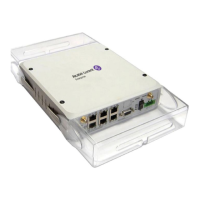Configuring a VPLS Service with CLI
Page 382 7750 SR OS Services Guide
The default value of max-age is 20. This parameter can be modified within a range of 6 to 40,
limited by the standard STP parameter interaction formulae.
CLI Syntax: config>service>vpls service-id# stp
max-age max-info-age
Range:
6 to 40 seconds
Default: 20 seconds
Restore Default: no max-age
Forward Delay
RSTP, as defined in the IEEE 802.1D-2004 standards, will normally transition to the forwarding
state via a handshaking mechanism (rapid transition), without any waiting times. If handshaking
fails (e.g. on shared links, see below), the system falls back to the timer-based mechanism defined
in the original STP (802.1D-1998) standard.
A shared link is a link with more than two Ethernet bridges (for example, a shared 10/100BaseT
segment). The
port-type command is used to configure a link as point-to-point or shared (see
section SAP Link Type on page 392).
For timer-based transitions, the 802.1D-2004 standard defines an internal variable forward-delay,
which is used in calculating the default number of seconds that a SAP or spoke SDP spends in the
discarding and learning states when transitioning to the forwarding state.
The value of the forward-delay variable depends on the STP operating mode of the VPLS
instance:
•in
rstp mode, but only when the SAP or spoke SDP has not fallen back to legacy STP
operation, the value configured by the
hello-time command is used;
• in all other situations, the value configured by the
forward-delay command is used.
CLI Syntax: config>service>vpls service-id# stp
forward-delay seconds
Range:
4 to 30 seconds
Default: 15 seconds
Restore Default: no forward-delay

